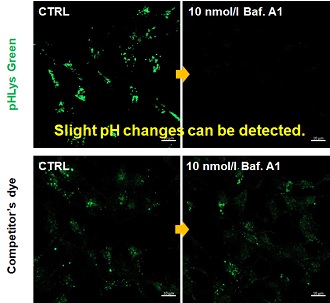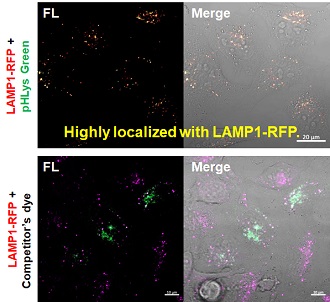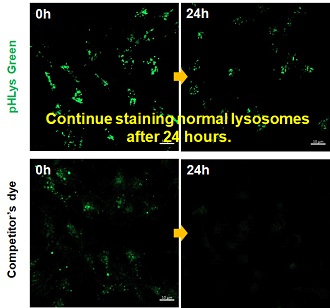|
Through a combination of various scientific methods, this research reveals the vital role of human lysosome-associated membrane proteins (LAMP-1 and LAMP-2) in maintaining lysosomal pH balance. Despite being mainly recognized as lysosomal markers, LAMP-1 and LAMP-2 directly influence the lysosomal cation channel TMEM175, aiding the acidification of lysosomes to a pH level that optimizes hydrolase activity. Interruptions to the interaction between LAMP and TMEM175 can increase lysosomal pH, impairing their hydrolytic function.
We offer small fluorescent probes for detecting lysosomal mass and pH with several color options: Lysosomal Acidic pH Detection kit-Green/Red and Green/Deep Red.
|
|
Lysosomal LAMP proteins regulate lysosomal pH by direct inhibition of the TMEM175 channel
Click here for the original article: Jiyuan Zhang, et. al., Mol. Cell. (2023)
Point of Interest
- The lysosomal proteins LAMP-1 and LAMP-2 have a direct interaction with the TMEM175 channel.
- This complex formation between TMEM175 and LAMPs is facilitated by their transmembrane (TM) domains.
- The binding of LAMP proteins inhibits the channel activity of TMEM175.
- This inhibition of TMEM175 promotes lysosomal acidification, thereby enhancing the efficiency of hydrolase activity.
|
|
Related Techniques
|
- Lipid droplets detection
- Lysosomal Acidic pH Detection Kit-Green/Red, Green/Deep Red
|
- Lysosome staining
- pH-dependent (Red) and pH-independent (Green / Deep Red) probes
|
- Autophagy detection
- DAPGreen / DAPRed (Autophagosome detection), DALGreen (Autolysosome detection)
|
- Endocytosis detection
- ECGreen
|
- Endocytic internalization assay
- AcidSensor Labeling Kit
|
- Plasma membrane staining
- PlasMem Bright Green / Red
|
- Total ROS detection
- Highly sensitive DCFH-DA or Photo-oxidation Resistant DCFH-DA
|
|
Related Applications
|
Accurate Measurement for Lysosomal pH changes
Existing lysosomal pH detection reagents have issues with dye localization, pH sensitivity, and retention. pHLys Green is a dye that solves these issues. The improved dye retention and localization enable detection of normal lysosomes, and the improved pH sensitivity enables detection of slight pH changes.
-
| 1. High sensitive pH detection |
|
Comparison of pH response of cells treated with low concentrations of lysosomal acidification inhibitor Bafilomycin A1

|
-
| 2. High specificity for lysosomes |
|
Comparison of specificity for lysosomes using lysosomal marker protein LAMP1-GFP expressing cells

|
-
| 3. High retention in lysosomes |
|
Comparison of intracellular retention

|
|


















